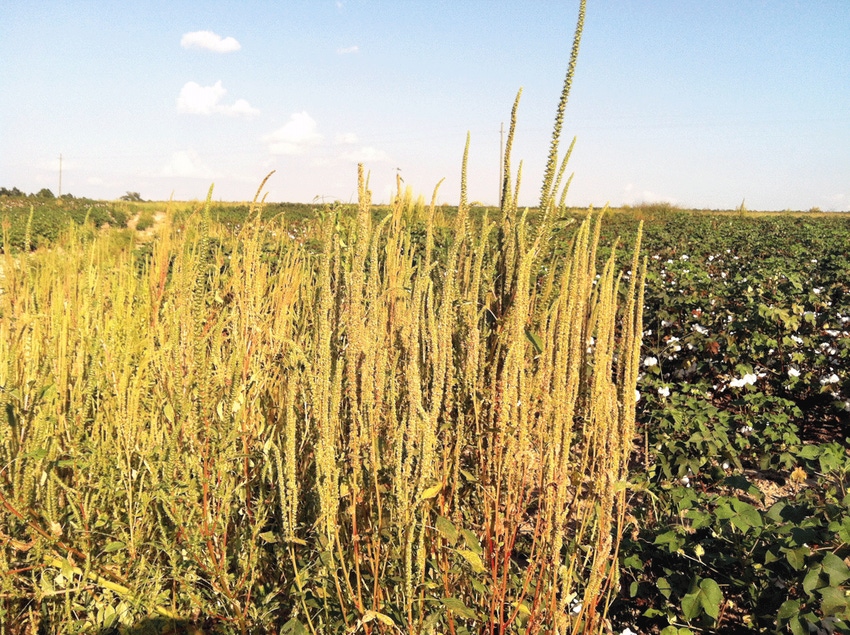June 18, 2014

While help is on the way for cotton producers battling resistant pigweed, timeliness of applications still will be the key to managing this devastating pest, according to research from this past year.
Some of the new herbicide combinations will improve flexibility to a point, but if you have good growing conditions for the prolific Palmer amaranth, they might offer only a few days, says Jeremy Kichler, an Extension agent in Colquitt County, Ga.
And very few people in the lower Southeast can speak with the experience of Kichler, who helped to confirm the first case of glyphosate-resistant Palmer amaranth in Macon County, which is known as “ground zero” for the weed in Georgia.
“Soon, cotton growers will have access to 2,4-D and dicamba technologies,” says Kichler. “Information is needed to determine the most effective mixtures for growers to control problematic weeds like glyphosate-resistant Palmer amaranth and grasses. Our field experiments evaluated possible tank-mixes of glyphosate, glufosinate, 2,4-D and/or dicamba on Palmer amaranth and Texas panicum.”
Weed resistance has been the primary issue for cotton producers in Macon County, he says. “I’ve seen growers in middle Georgia struggle with this pest for eight or nine years now. In helping my growers with this issue, I’ve seen my better growers use tactics such as managing the seed bank, using overlapping residual herbicides in their herbicide programs, and also the widespread adoption of Liberty-based programs. Practices such as this have become more common now, and we’re spending a lot of money to help keep our fields clean.”
Kichler says his growers are excited about the 2,4-D and Clarity technology that’ll be available in a few years. They see it as another tool to help manage glyphosate-resistant Palmer amaranth, he says.
But regardless of the technology, timeliness will still be a necessity, he adds. “If you look at the research on Liberty-based or auxin-based programs, we talk about the importance of timely applications to make these systems work. In our Extension-based programs for managing weed resistance, we stress to our growers about timely applications. Crop consultants are faced with daily situations where growers are trying to cover more acres, and sometimes we have issues with making timely herbicide applications, especially when we’re managing large Palmer amaranth,” says Kichler.
The objective of the field experiments this past year was to find the most effective dicamba or 2,4-D mixture for controlling annual grasses and Palmer amaranth, he says. The treatments included an untreated check, 2,4-D Amine at 24 ounces per acre, Clarity at 12 ounces per acre, Roundup at 32 ounces per acre, and Liberty at 32 ounces per acre.
Researchers also evaluated the effectiveness of various tank-mix combinations. “We used Roundup plus 2,4-D or Clarity, Liberty plus 2,4-D or Clarity, and Roundup plus Liberty plus 2,4-D or Clarity.”
There were two locations in the trial, one in Macon County and one in Tift County in southwest Georgia.
The trials of control
The size of the Palmer amaranth ranged from 6 to 14 inches tall, says Kichler. “In Macon County, the population was highly resistant while in Tift County, we had more of mixed population of glyphosate-resistant Palmer amaranth.”
At 20 days after treatment, when the percent of Palmer amaranth control was evaluated in Tift County, 2,4-D, Clarity and Liberty were the most effective while Roundup was the least effective. Roundup gave about 50-percent control, he says.
“All of the combinations were significantly better than Liberty or Roundup alone. Control increased when we combined 2,4-D with glyphosate. The population in Tift County did have some sensitivity to glyphosate. We had great control with the three-way combination of Roundup, Liberty and 2,4-D and also Roundup, Liberty and Clarity.”
In Macon County, at 22 days after treatment, control was terrible, he says, with 2,4-D and Clarity being the most effective treatments among the herbicides that were applied by themselves.
“But we still had less than 60 percent control. Roundup was the least effective at 30 percent control. When we looked at the combinations, control also was terrible with those. But all combinations were better than Liberty or Roundup applied by themselves. The Liberty plus Clarity, Roundup plus Liberty plus Clarity, and Roundup and Liberty tank-mixed with 2,4-D were the most effective in Macon County.
“Roundup and Liberty tank-mixed with 2,4-D was very effective in Tift County, but the pigweed got ahead of us in Macon County. Clarity in that tank-mix was very effective in Tift County with the sensitive population there.”
Looking at the percent of grass control 22 days after planting in Tift and Macon Counties, Kichler says Roundup applied alone was the most effective, but 2,4-D and Clarity was least effective, giving less than 20 percent control.
Evaluating the annual grasses with the tank-mix combinations, the Roundup combinations gave similar control to Roundup applied alone, he says.
“The Liberty plus 2,4-D or Liberty tank-mixed with Clarity gave us similar control compared to Liberty applied alone. But when we looked at the three-way combinations of Roundup, Liberty and Clarity, and Roundup, Liberty plus 2,4-D, control was increased significantly, and those two treatments gave us similar control as Roundup applied by itself. In Tift County, we had really good control with our Roundup tank-mixes – Roundup and Roundup plus 2,4-D.:
In summary, says Kichler, Roundup plus Liberty plus the auxin mixes were the most effective options.
“The control of large Palmer amaranth was good in Tift County, but the population was more sensitive to glyphosate. In Macon County, where we had full resistance to glyphosate, control was very poor. The auxin combinations improved grower flexibility to a point, but if you have good growing conditions – considering how Palmer amaranth grows – it might give you only a few days of flexibility.”
Want access to the very latest in agriculture news each day? Subscribe to Southeast Farm Press Daily. It’s free!
About the Author(s)
You May Also Like




